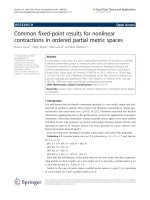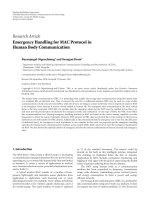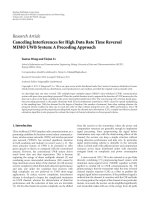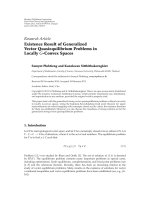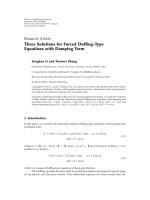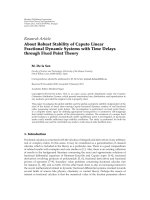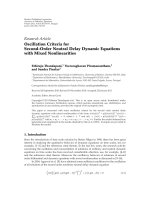Báo cáo hóa học: " Research Article Fixed-Point Results for Generalized Contractions on Ordered Gauge Spaces with Applications" pdf
Bạn đang xem bản rút gọn của tài liệu. Xem và tải ngay bản đầy đủ của tài liệu tại đây (497.75 KB, 10 trang )
Hindawi Publishing Corporation
Fixed Point Theory and Applications
Volume 2011, Article ID 979586, 10 pages
doi:10.1155/2011/979586
Research Article
Fixed-Point Results for Generalized Contractions
on Ordered Gauge Spaces with Applications
Cristian Chifu and Gabriela Petrus¸el
Faculty of Business, Babes¸-Bolyai University, Horia Street no. 7, 400174 Cluj-Napoca, Romania
Correspondence should be addressed to Cristian Chifu,
Received 6 December 2010; Accepted 31 December 2010
Academic Editor: Jen Chih Yao
Copyright q 2011 C. Chifu and G. Petrus¸el. This is an open access article distributed under
the Creative Commons Attribution License, which permits unrestricted use, distribution, and
reproduction in any medium, provided the original work is properly cited.
The p urpose of this paper is to present some fixed-point results for single-valued ϕ-contractions
on ordered and complete gauge space. Our theorems generalize and extend some recent results in
the literature. As an application, existence results for some integral equations on the positive real
axis are given.
1. Introduction
Throughout this paper will denote a nonempty set E endowed with a separating gauge
structure D {d
α
}
α∈Λ
,whereΛ is a directed set see 1 for definitions.Let : {0, 1, 2, }
and
∗
: \{0}.Wealsodenoteby the set of all real numbers and by
:0, ∞.
Asequencex
n
of elements in E is said to be Cauchy if for every ε>0andα ∈ Λ,
there is an N with d
α
x
n
,x
np
≤ ε for all n ≥ N and p ∈
∗
.Thesequencex
n
is called
convergent if there exists an x
0
∈ X such tha t for every ε>0andα ∈ Λ,thereisanN ∈
∗
with d
α
x
0
,x
n
≤ ε,foralln ≥ N.
A gauge space
is called complete if any Cauchy sequence is convergent. A subset of
X is said to be closed if it contains the limit of any convergent sequence of its elements. S ee
also Dugundji 1 for other definitions and details.
If f : E → E is an operator, then x ∈ E is called fixed point for f if and only if x fx.
The set F
f
: {x ∈ E | x fx} denotes the fixed-point set of f.
On the other hand, Ran and Reurings 2 proved the following Banach-Caccioppoli
type principle in ordered metric spaces.
Theorem 1.1 Ran and Reurings 2. Let X be a partially ordered set such that every pair x, y ∈ X
has a lower and an upper bound. Let d be a metric on X such that the metric space X, d is complete.
2 Fixed Point Theory and Applications
Let f : X → X be a continuous and monotone (i.e., either decreasing or increasing) operator. Suppose
that the following two assertions hold:
1 there exists a ∈ 0, 1 such that dfx,fy ≤ a · dx, y,foreachx, y ∈ X with x ≥ y;
2 there exists x
0
∈ X such that x
0
≤ fx
0
or x
0
≥ fx
0
.
Then f has an unique fixed point x
∗
∈ X,thatis,fx
∗
x
∗
,andforeachx ∈ X the sequence
f
n
x
n∈
of successive approximations of f starting from x converges to x
∗
∈ X.
Since then, several authors considered the problem of existence and uniqueness of a
fixed point for contraction-type operators on partially ordered sets.
In 2005, Nieto and Rodrguez-L
´
opez proved a modified variant of Theorem 1.1,by
removing the continuity of f. The case of decreasing operators is treated in Nieto and
Rodrguez-L
´
opez 3, where some interesting applications to ordinary differential equations
with periodic boundary conditions are also given. Nieto, Pouso, and Rodrguez-L
´
opez, in a
very recent paper, improve some results given by Petrus¸el and Rus in 4 in the s etting of
abstract L-spaces in the sense of Fr
´
echet, see, for example, 5,Theorems3.3and3.5.Another
fixed-point result of this type was given by O’Regan and Petrus¸el in 6 for the case of ϕ-
contractions in ordered complete metric spaces.
The aim of this paper is to present some fixed-point theorems for ϕ-contractions on
ordered and complete gauge space. As an application, existence results for some integral
equations on the positive real axis are given. Our theorems generalize the above-mentioned
theorems as well as some other ones in the recent literature see; Ran and Reurings 2 ,Nieto
and Rodrguez-L
´
opez 3, 7,Nietoetal.5,Petrus¸el and Rus 4, Agarwal et al. 8,O’Regan
and Petrus¸el 6,etc..
2. Preliminaries
Let X be a nonempty set and f : X → X be an operator. Then, f
0
: 1
X
, f
1
: f, ,f
n1
f ◦ f
n
, n ∈ denote the iterate operators of f.LetX be a nonempty set and let sX :
{x
n
n∈N
| x
n
∈ X, n ∈ N}.LetcX ⊂ sX asubsetofsX and Lim : cX → X
an operator. By definition the triple X, cX, Lim is called an L-space Fr
´
echet 9 if the
following conditions are satisfied.
i If x
n
x,foralln ∈ N,thenx
n
n∈N
∈ cX and Limx
n
n∈N
x.
ii If x
n
n∈N
∈ cX and Limx
n
n∈N
x, then for all subsequences, x
n
i
i∈N
,of
x
n
n∈N
we have that x
n
i
i∈N
∈ cX and Limx
n
i
i∈N
x.
By definition, an element of cX is a convergent sequence, x : Limx
n
n∈N
is the
limit of this sequence and we also write x
n
→ x as n → ∞.
InwhatfollowwedenoteanL-space by X, → .
In this setting, if U ⊂ X × X,thenanoperatorf : X → X is called orbitally U-
continuous see 5 if x ∈ X and f
ni
x → a ∈ X,asi → ∞ and f
ni
x,a ∈ U for
any i ∈
imply f
ni1
x → fa,asi → ∞. In particular, if U X × X,thenf is called
orbitally continuous.
Let X, ≤ be a partially ordered set, that is, X is a nonempty set and ≤ is a reflexive,
transitive, and antisymmetric relation on X.Denote
X
≤
:
x, y
∈ X × X | x ≤ y or y ≤ x
. 2.1
Fixed Point Theory and Applications 3
Also, if x, y ∈ X,withx ≤ y then by x, y
≤
we will denote the ordered segment joining x
and y,thatis,x, y
≤
: {z ∈ X | x ≤ z ≤ y}. In the same setting, consider f : X → X. Then,
LF
f
: {x ∈ X | x ≤ fx} is the lower fixed-point set of f, while UF
f
: {x ∈ X | x ≥ fx}
is the upper fixed-point set of f. Also, if f : X → X and g : Y → Y, then the cartesian product
of f and g is denoted by f × g, and it is defined in the following way: f × g : X × Y → X × Y,
f × gx, y :fx,gy.
Definition 2.1. Let X be a nonempty set. By definition X, → , ≤ is an ordered L-space if and
only if
iX, → is an L-space;
iiX, ≤ is a partially ordered set;
iii
x
n
n∈
→ x, y
n
n∈
→ y and x
n
≤ y
n
,foreachn ∈ ⇒ x ≤ y.
If
:E, D is a gauge space, then the convergence structure is given by the family of
gauges D {d
α
}
α∈Λ
.Hence,E, D, ≤ is an ordered L-space, and it will be called an ordered
gauge space, see also 10, 11.
Recall that ϕ :
→
is said to be a comparison function if it is increasing and
ϕ
k
t → 0, as k → ∞. As a consequence, we also have ϕt <t,foreacht>0, ϕ00
and ϕ is right continuous at 0. For example, ϕtat where a ∈ 0, 1, ϕtt/1 t and
ϕtln1 t, t ∈
are comparison functions.
Recall now the following important abstract concept.
Definition 2.2 Rus 12.LetX, → be an L-space. An operator f : X → X is, by definition,
aPicardoperatorif
i F
f
{x
∗
};
iif
n
x
n∈
→ x
∗
as n →∞,forallx ∈ X.
Several classical results in fixed-point theory can be easily transcribed in terms of the
Picard operators, see 4, 13, 14.InRus12 the basic theory of Picard operators is presented.
3. Fixed-Point Results
Our fi rst main result is the following existence, uniqueness, and approximation fixed-point
theorem.
Theorem 3.1. Let E, D, ≤ be an ordered complete gauge space and f : E → E be an operator.
Suppose that
i for each x, y ∈ E with x, y /∈ X
≤
there exists cx, y ∈ E such that x, cx, y ∈ X
≤
and y, cx, y ∈ X
≤
;
ii X
≤
∈ If × f;
iii if x, y ∈ X
≤
and y, z ∈ X
≤
,thenx, z ∈ X
≤
;
iv there exists x
0
∈ X
≤
such that x
0
,fx
0
∈ X
≤
;
4 Fixed Point Theory and Applications
v f is orbitally continuous;
vi there exists a comparison function ϕ :
→
such that, for each α ∈ Λ one has
d
α
f
x
,f
y
≤ ϕ
d
α
x, y
, for each
x, y
∈ X
≤
. 3.1
Then, f is a Picard operator.
Proof. Let x
0
∈ E be such that x
0
,fx
0
∈ X
≤
. Suppose first that x
0
/
fx
0
. Then, from ii
we obtain
f
x
0
,f
2
x
0
,
f
2
x
0
,f
3
x
0
, ,
f
n
x
0
,f
n1
x
0
, ,∈ X
≤
. 3.2
From vi,byinduction,weget,foreachα ∈ Λ,that
d
α
f
n
x
0
,f
n1
x
0
≤ ϕ
n
d
α
x
0
,f
x
0
, for each n ∈
. 3.3
Since ϕ
n
d
α
x
0
,fx
0
→ 0asn → ∞, for an arbitrary ε>0 we can choose N ∈
∗
such
that d
α
f
n
x
0
,f
n1
x
0
<ε−ϕε,foreachn ≥ N.Sincef
n
x
0
,f
n1
x
0
∈ X
≤
for all n ∈ ,
we have for all n ≥ N that
d
α
f
n
x
0
,f
n2
x
0
≤ d
α
f
n
x
0
,f
n1
x
0
d
α
f
n1
x
0
,f
n2
x
0
<ε− ϕ
ε
ϕ
d
α
f
n
x
0
,f
n1
x
0
≤ ε.
3.4
Now since f
n
x
0
,f
n2
x
0
∈ X
≤
see iii we have for any n ≥ N that
d
α
f
n
x
0
,f
n3
x
0
≤ d
α
f
n
x
0
,f
n1
x
0
d
f
n1
x
0
,f
n3
x
0
<ε− ϕ
ε
ϕ
d
α
f
n
x
0
,f
n2
x
0
≤ ε.
3.5
By induction, for each α ∈ Λ,wehave
d
α
f
n
x
0
,f
nk
x
0
<ε, for any k ∈
∗
,n≥ N. 3.6
Hence f
n
x
0
n∈
is a Cauchy sequence in . From the completeness of the gauge space we
have f
n
x
0
n∈
→ x
∗
,asn → ∞.
Let x ∈ E be arbitrarily chosen. T hen;
1 If x, x
0
∈ X
≤
then f
n
x,f
n
x
0
∈ X
≤
and thus, for each α ∈ Λ,wehave
d
α
f
n
x,f
n
x
0
≤ ϕ
n
d
α
x, x
0
,foreachn ∈ . Letting n → ∞ we obtain that
f
n
x
n∈
→ x
∗
.
Fixed Point Theory and Applications 5
2 If x, x
0
/∈ X
≤
then, by i,thereexistscx, x
0
∈ E such that x, cx, x
0
∈ X
≤
and x
0
,cx, x
0
∈ X
≤
. From t he second relation, a s before, we get, for each α ∈
Λ,thatd
α
f
n
x
0
,f
n
cx, x
0
≤ ϕ
n
d
α
x
0
,cx, x
0
,foreachn ∈ and hence
f
n
cx, x
0
n∈
→ x
∗
,asn → ∞. Then, using the first relation we infer that, for
each α ∈ Λ,wehaved
α
f
n
x,f
n
cx, x
0
≤ ϕ
n
d
α
x, cx, x
0
,foreachn ∈ .
Letting again n → ∞,weconcludef
n
x
n∈
→ x
∗
.
By the orbital continuity of f we get that x
∗
∈ F
f
.Thusx
∗
fx
∗
.Ifwehavefyy
for some y ∈ E, then from above, we must have f
n
y → x
∗
,soy x
∗
.
If fx
0
x
0
,thenx
0
plays the role of x
∗
.
Remark 3.2. Equivalent representation of condition iv are as follows.
iv’Thereexistsx
0
∈ E such that x
0
≤ fx
0
or x
0
≥ fx
0
iv” LF
f
∪ UF
f
/
∅.
Remark 3.3. Condition ii can be replaced by each of the following assertions:
ii’ f : E, ≤ → E, ≤ is increasing,
ii” f : E, ≤ → E, ≤ is decreasing.
However, it is easy to see that assertion ii in Theorem 3.1. is more general.
As a consequence of Theorem 3.1, we have the following result very useful for
applications.
Theorem 3.4. Let E, D, ≤ be an ordered complete gauge space and f : E → E be an operator. One
supposes that
i for each x, y ∈ E with x, y /∈ X
≤
there exists cx, y ∈ E such that x, cx, y ∈ X
≤
and y, cx, y ∈ X
≤
;
ii f : E, ≤ → E, ≤ is increasing;
iii there exists x
0
∈ E such that x
0
≤ fx
0
;
iv
a f is orbitally continuous or
b if an increasing sequence x
n
n∈
converges to x in E,thenx
n
≤ x for all n ∈ ;
v there exists a comparison function ϕ :
→
such that
d
α
f
x
,f
y
≤ ϕ
d
α
x, y
, for each
x, y
∈ X
≤
,α∈ Λ; 3.7
vi if x, y ∈ X
≤
and y, z ∈ X
≤
,thenx, z ∈ X
≤
.
Then f is a Picard operator.
6 Fixed Point Theory and Applications
Proof. Since f : E, ≤ → E, ≤ is increasing and x
0
≤ fx
0
we immediately have
x
0
≤ fx
0
≤ f
2
x
0
≤ ···f
n
x
0
≤ ···.Hencefromv we obtain d
α
f
n
x
0
,f
n1
x
0
≤
ϕ
n
d
α
x
0
,fx
0
,foreachn ∈ . By a similar approach as in the pr oof of Theorem 3.1 we
obtain
d
α
f
n
x
0
,f
nk
x
0
<ε, for any k ∈
∗
,n≥ N, 3.8
Hence f
n
x
0
n∈
is a Cauchy sequence in . From the completeness of the gauge space we
have that f
n
x
0
n∈
→ x
∗
as n → ∞.
By the orbital continuity of the operator f we get that x
∗
∈ F
f
.Ifivb takes place,
then, since f
n
x
0
n∈
→ x
∗
, given any >0thereexistsN
∈
∗
such that for each n ≥ N
we have d
α
f
n
x
0
,x
∗
<. On the other hand, for each n ≥ N
,sincef
n
x
0
≤ x
∗
,wehave,
for each α ∈ Λ that
d
α
x
∗
,f
x
∗
≤ d
α
x
∗
,f
n1
x
0
d
α
f
f
n
x
0
,f
x
∗
≤ d
α
x
∗
,f
n1
x
0
ϕ
d
α
f
n
x
0
,x
∗
< 2.
3.9
Thus x
∗
∈ F
f
.
The uniqueness of the fixed point follows by contradiction. Suppose there exists y
∗
∈
F
f
,withx
∗
/
y
∗
. There are two possible cases.
a If x
∗
,y
∗
∈ X
≤
,thenwehave0 <d
α
y
∗
,x
∗
d
α
f
n
y
∗
,f
n
x
∗
≤
ϕ
n
d
α
y
∗
,x
∗
→ 0asn → ∞, which is a contradiction. Hence x
∗
y
∗
.
b If x
∗
,y
∗
/∈ X
≤
then there exists c
∗
∈ E such that x
∗
,c
∗
∈ X
≤
and y
∗
,c
∗
∈ X
≤
.
The monotonicity condition implies that f
n
x
∗
and f
n
c
∗
are comparable
as well as f
n
c
∗
and f
n
y
∗
.Hence0 <d
α
y
∗
,x
∗
d
α
f
n
y
∗
,f
n
x
∗
≤
d
α
f
n
y
∗
,f
n
c
∗
d
α
f
n
c
∗
,f
n
x
∗
≤ ϕ
n
d
α
y
∗
,c
∗
ϕ
n
d
α
c
∗
,x
∗
→ 0as
n → ∞, which is again a contradiction. Thus x
∗
y
∗
.
4. Applications
We will apply the above result to nonlinear integral equations on the real axis
x
t
t
0
K
t, s, x
s
ds g
t
,t∈
. 4.1
Theorem 4.1. Consider 4.1. Suppose that
i K :
×
×
n
→
n
and g :
→
n
are continuous;
ii Kt, s, · :
n
→
n
is increasing for each t, s ∈
;
iii there exists a comparison function ϕ :
→
,withϕλt ≤ λϕt for each t ∈
and
any λ ≥ 1,suchthat
|
K
t, s, u
− K
t, s, v
|
≤ ϕ
|
u − v
|
, for each t, s ∈
,u,v∈
n
,u≤ v; 4.2
Fixed Point Theory and Applications 7
iv there exists x
0
∈ C
,
n
such that
x
0
t
≤
t
0
K
t, s, x
0
s
ds g
t
, for any t ∈
. 4.3
Then the integral equation 4.1 has a unique solution x
∗
in C0, ∞,
n
.
Proof. Let E : C0, ∞,
n
and the family of pseudonorms
x
n
: max
t∈0,n
|
x
t
|
e
−τt
, where τ>0. 4.4
Define now d
n
x, y : x − y
n
for x, y ∈ E.
Then D :d
n
n∈
∗
is family of gauges on E.ConsideronE the partial order defined
by
x ≤ y if and only if x
t
≤ y
t
for any t ∈
. 4.5
Then E, D, ≤ is an ordered and complete gauge space. Moreover, for any increasing
sequence x
n
n∈
in E converging to some x
∗
∈ E we have x
n
t ≤ x
∗
t,foranyt ∈ 0, ∞.
Also, for every x, y ∈ E there exists cx, y ∈ E which is comparable to x and y.
Define A : C0, ∞,
n
→ C0, ∞,
n
,bytheformula
Ax
t
:
t
0
K
t, s, x
s
ds g
t
,t∈
. 4.6
First observe that from ii A is increasing. Also, for each x, y ∈ E with x ≤ y and for
t ∈ 0,n,wehave
Ax
t
− Ay
t
≤
t
0
K
t, s, x
s
− K
t, s, y
s
ds ≤
t
0
ϕ
x
s
− y
s
ds
t
0
ϕ
x
s
− y
s
e
−τs
e
τs
ds ≤
t
0
e
τs
ϕ
x
s
− y
s
e
−τs
ds
≤ ϕ
d
n
x, y
t
0
e
τs
ds ≤
1
τ
ϕ
d
n
x, y
e
τt
.
4.7
Hence, for τ ≥ 1weobtain
d
n
Ax, Ay
≤ ϕ
d
n
x, y
, for each x,y ∈ X, x ≤ y. 4.8
From iv we have that x
0
≤ Ax
0
. The conclusion follows now from Theorem 3.4.
8 Fixed Point Theory and Applications
Consider now the following equation:
x
t
t
−t
K
t, s, x
s
ds g
t
,t∈ . 4.9
Theorem 4.2. Consider 4.9. Suppose that
i K :
× ×
n
→
n
and g : →
n
are continuous;
ii Kt, s, · :
n
→
n
is increasing for each t, s ∈ ;
iii there exists a comparison function ϕ :
→
,withϕλt ≤ λϕt for each t ∈
and
any λ ≥ 1,suchthat
|
K
t, s, u
− K
t, s, v
|
≤ ϕ
|
u − v
|
, for each t, s ∈
,u,v∈
n
,u≤ v; 4.10
iv there exists x
0
∈ C ,
n
such that
x
0
t
≤
t
−t
K
t, s, x
0
s
ds g
t
, for any t ∈
. 4.11
Then the integral equation 4.9 has a unique solution x
∗
in C ,
n
.
Proof. We consider the gauge space E :C
,
n
, D :d
n
n∈
where
d
n
x, y
max
−n≤t≤n
x
t
− y
t
· e
−τ|t|
,τ>0, 4.12
and the operator B : E → E defined by
Bx
t
t
−t
K
t, s, x
s
ds g
t
. 4.13
As before, consider on E the partial order defined by
x ≤ y iff x
t
≤ y
t
for any t ∈
. 4.14
Then E, D, ≤ is an ordered and complete gauge space. Moreover, for any increasing
sequence x
n
n∈
in E converging to a certain x
∗
∈ E we have x
n
t ≤ x
∗
t,foranyt ∈ .
Also, for every x, y ∈ E there exists cx, y ∈ E which is comparable to x and y.Noticethat
ii implies that B is increasing.
Fixed Point Theory and Applications 9
From condition iii,forx, y ∈ E with x ≤ y,wehave
Bx
t
− By
t
≤
t
−t
ϕ
x
s
− y
s
e
−τ|s|
e
τ|s|
ds
≤
t
−t
e
τ|s|
ϕ
x
s
− y
s
e
−τ|s|
ds ≤ ϕ
d
n
x, y
t
−t
e
τ|s|
ds
≤ ϕ
d
n
x, y
|t|
−
|
t
|
e
τ|s|
ds ≤
2
τ
ϕ
d
n
x, y
e
τ|t|
,t∈
−n; n
.
4.15
Thus, for any τ ≥ 2, we obtain
d
n
B
x
,B
y
≤ ϕ
d
n
x, y
, ∀ x, y ∈ E, x ≤ y, for n ∈
. 4.16
As before, from iv we have that x
0
≤ Bx
0
. The conclusion follows again by Theorem 3.4.
Remark 4.3. It is worth mentioning that it could be of interest to extend the above technique
for other metrical fixed-point theorems, see 15, 16, and so forth.
References
1 J. Dugundji, Topology, Allyn and Bacon, Boston, Mass, USA, 1966.
2 A. C. M. Ran and M. C. B. Reurings, “A fixed point theorem in partially ordered sets and some
applications to matrix equations,” Proceedings of the American Mathematical Society, vol. 132, no. 5, pp.
1435–1443, 2004.
3 J. J. Nieto and R. Rodr
´
ıguez-L
´
opez, “Existence and uniqueness of fixed point in partially ordered
sets and applications to ordinary differential equations,” Acta Mathematica Sinica, vol. 23, no. 12, pp.
2205–2212, 2007.
4 A. Petrus¸el and I. A. Rus, “Fixed point theorems in ordered L-spaces,” Proceedings of the American
Mathematical Society, vol. 134, no. 2, pp. 411–418, 2006.
5 J. J. Nieto, R. L. Pouso, and R. Rodr
´
ıguez-L
´
opez, “Fixed point theorems in ordered abstract spaces,”
Proceedings of the American Mathematical Society, vol. 135, no. 8, pp. 2505–2517, 2007.
6 D. O’Regan and A. Petrus¸el, “Fixed point theorems for generalized contractions in ordered metric
spaces,” Journal of Mathematical Analysis and Applications, vol. 341, no. 2, pp. 1241–1252, 2008.
7 J. J. Nieto and R. R odr
´
ıguez-L
´
opez, “Contractive mapping theorems in partially ordered sets and
applications to ordinary differential equations,” Order, vol. 22, no. 3, pp. 223–239, 2005.
8 R. P. Agarwal, M. A. El-Gebeily, and D. O’Regan, “Generalized contractions in partially ordered
metric spaces,” Applicable Analysis, vol. 87, no. 1, pp. 109–116, 2008.
9 M. Fr
´
echet, Les Espaces Abstraits, Gauthier-Villars, Paris, France, 1928.
10 G. Petrus¸el, “Fixed point results for multivalued contractions on ordered gauge spaces,” Central
European Journal of Mathematics, vol. 7, no. 3, pp. 520–528, 2009.
11 G. Petrus
¸el and I. Luca, “Strict fixed point results for multivalued contractions on gauge spaces,”
Fixed Point Theory, vol. 11, no. 1, pp. 119–124, 2010.
12 I. A. Rus, “Picard operators and applications,” Scientiae Mathematicae Japonicae, vol. 58, no. 1, pp. 191–
219, 2003.
13 I. A. Rus, “The theory of a metrical fixed point theoremml: theoretical and applicative relevances,”
Fixed Point Theory, vol. 9, no. 2, pp. 541–559, 2008.
14 I. A. Rus, A. Petrus¸el, and G. Petrus¸el, Fixed Point Theory, Cluj University Press, Cluj-Napoca,
Romania, 2008.
10 Fixed Point Theory and Applications
15 J. Caballero, J. Harjani, and K. Sadarangani, “Contractive-like mapping principles in ordered metric
spaces and application to ordinary differential equations,” Fixed Point Theory and Applications,vol.
2010, Article ID 916064, 14 pages, 2010.
16 J. Harjani and K. Sadarangani, “Fixed point theorems for weakly contractive mappings in partially
ordered sets,” Nonlinear Analysis. Theory, Methods & Applications, vol. 71, no. 7-8, pp. 3403–3410, 2009.
